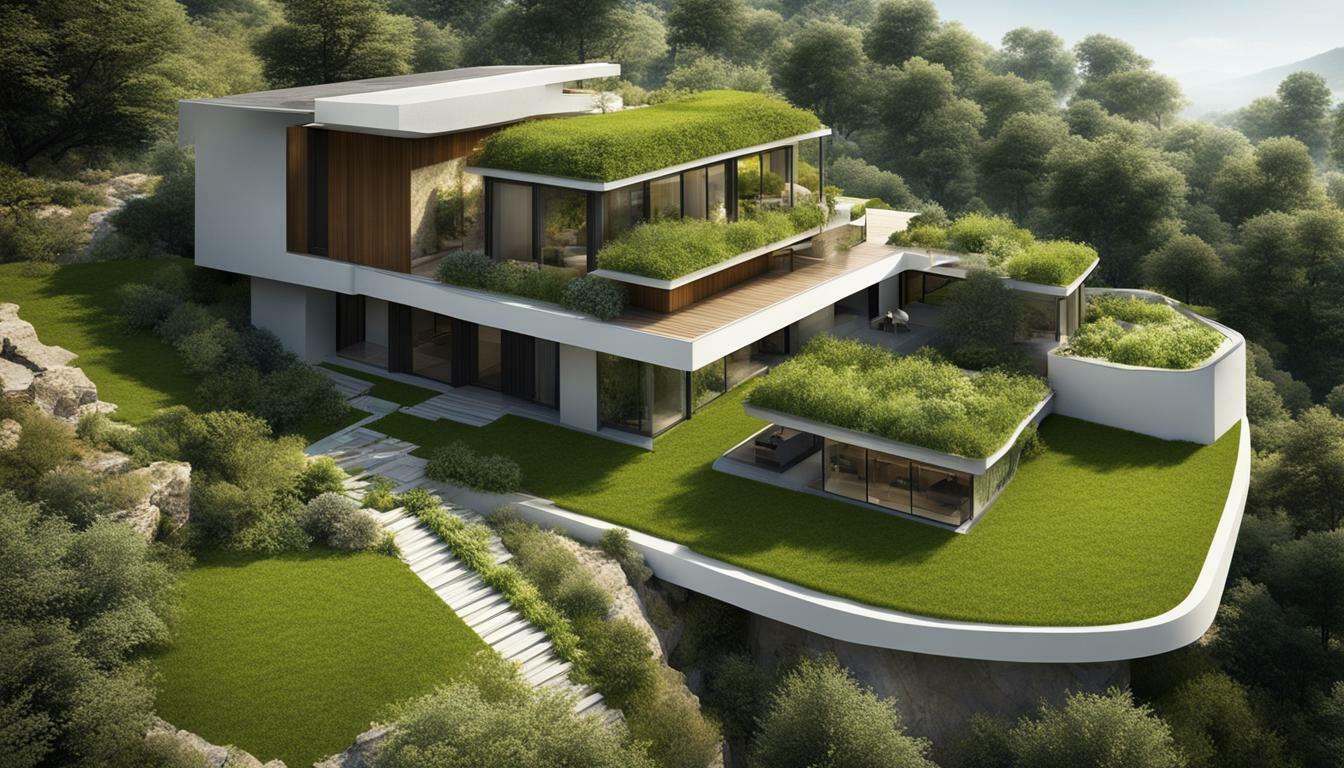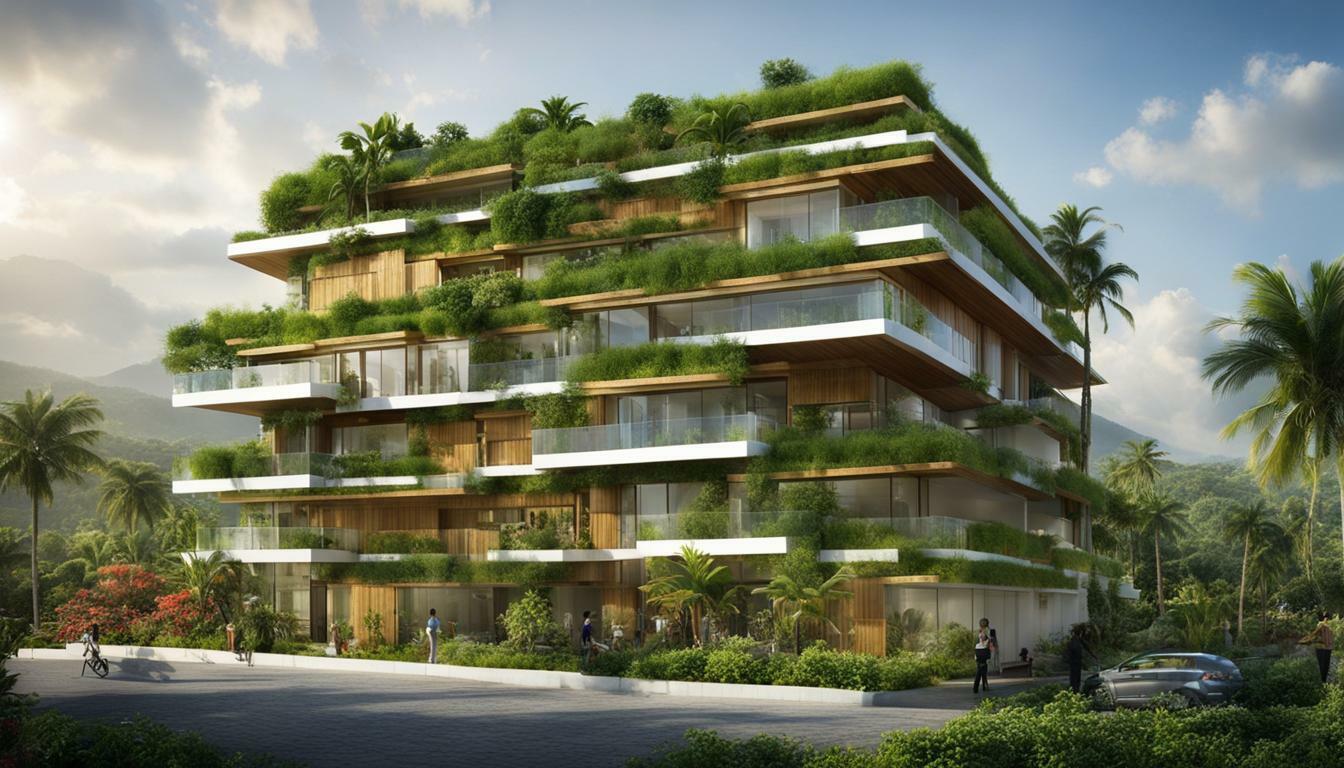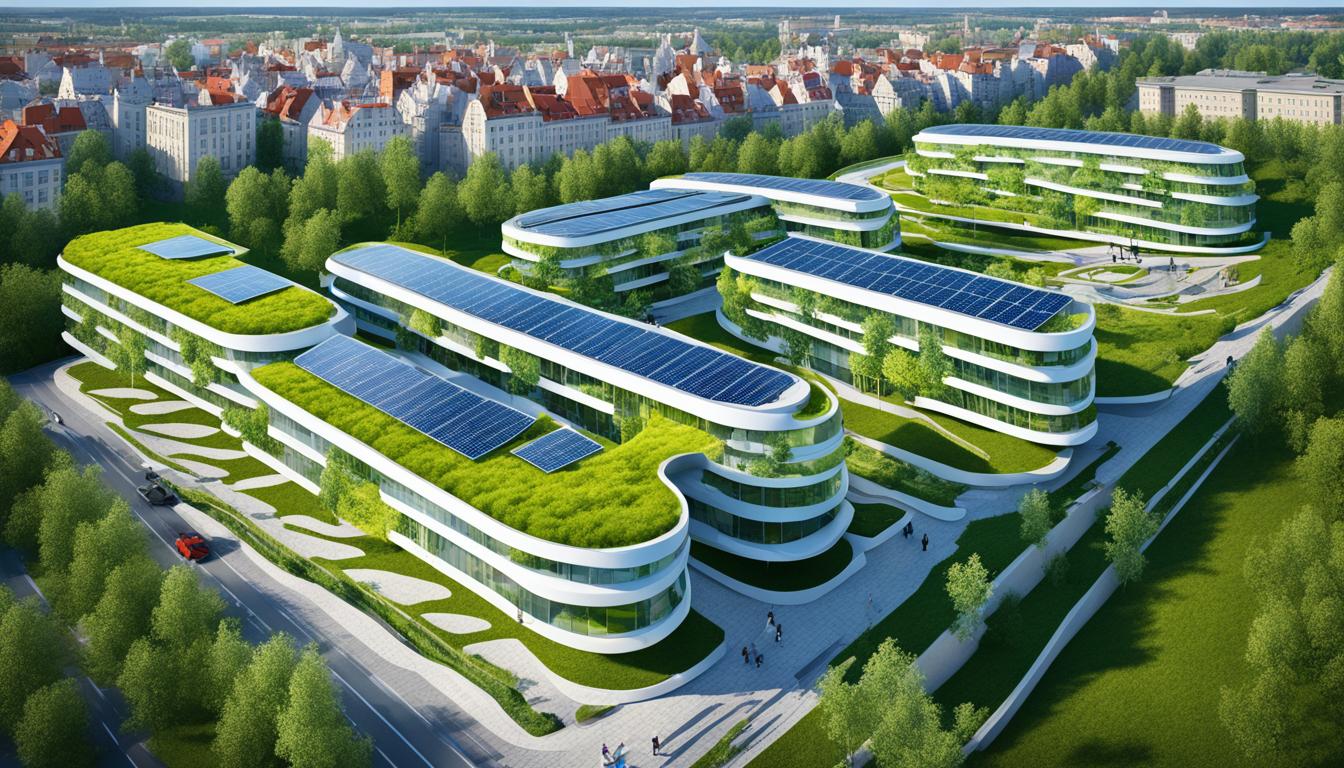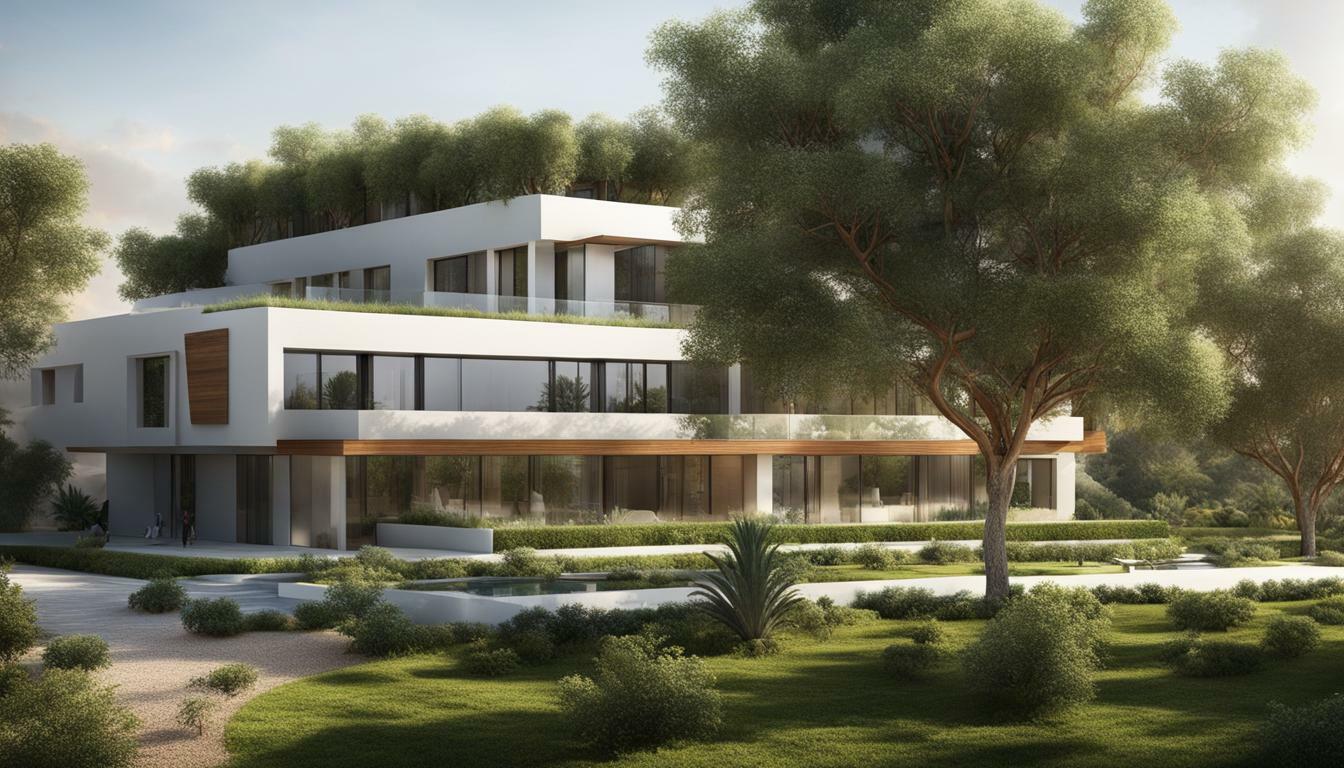Ecuador Top Green Buildings
Ecuador is home to several remarkable green buildings that showcase sustainable architecture and innovative construction practices. These buildings not only prioritize eco-friendly construction methods but also prioritize the use of sustainable materials and energy-efficient designs. One notable example is Casa Laguna, Ecuador’s largest affordable housing project, which utilized ECOPact green concrete to significantly reduce CO2 emissions. In addition to the environmental benefits, sustainable construction in Ecuador also has positive social and economic impacts, supporting local industries and creating employment opportunities.
- Ecuador has made significant strides in sustainable construction, with notable green buildings in the country.
- Casa Laguna is an exemplary project that used ECOPact green concrete to reduce CO2 emissions by 60%.
- Energy-efficient designs, such as optimizing natural lighting, ventilation, and insulation, are integrated into green buildings.
- Certification systems like LEED are widely recognized in Ecuador, promoting sustainability standards.
- Sustainable construction has positive social and economic impacts, supporting local industries and creating employment opportunities.
Sustainable Construction in Ecuador
Sustainable construction practices play a crucial role in Ecuador’s commitment to reducing environmental impact through initiatives like green building certification and the use of sustainable materials. The country has made significant strides in this area, with several notable green buildings that exemplify Ecuador’s dedication to sustainable architecture and environmentally-friendly construction.
One outstanding example is Casa Laguna, Ecuador’s largest affordable housing project. This innovative development utilized ECOPact green concrete, supplied by Holcim Ecuador, to significantly reduce CO2 emissions. By using low-carbon concrete, Casa Laguna successfully reduced its carbon footprint by an impressive 60%. This project consisted of 3,500 houses constructed with load-bearing walls, showcasing the effective use of sustainable materials in large-scale construction projects.
Ecuador’s construction industry also emphasizes energy-efficient designs to further minimize environmental impact. Building designs focus on maximizing natural lighting, ventilation, and insulation to reduce reliance on artificial lighting and HVAC systems. This approach not only reduces energy consumption but also creates more comfortable and sustainable living spaces.
Recognition and certification systems, such as LEED (Leadership in Energy and Environmental Design), are widely embraced in Ecuador. The implementation of green building certification ensures that sustainable construction practices adhere to internationally recognized standards. By meeting these stringent criteria, green buildings in Ecuador are acknowledged for their commitment to sustainability and their positive contributions to the environment.
| Certification systems | Standards |
|---|---|
| LEED | Internationally recognized |
| Ecuador Green Building Council (GBC) | National standards for sustainable construction |
| BREEAM | Assessment and certification of building sustainability |
In addition to environmental benefits, sustainable construction practices in Ecuador also have positive social and economic impacts. By prioritizing local industries and utilizing sustainable materials, the construction sector supports the growth of Ecuador’s economy and creates employment opportunities for its citizens. This holistic approach ensures that sustainability extends beyond the environment and positively impacts the community as a whole.
Building a Greener Future
Ecuador’s construction industry serves as a shining example of how innovative practices can harmonize with nature to build a greener future. Through sustainable architecture, green building certification, and the use of sustainable materials, Ecuador is significantly reducing its environmental footprint while simultaneously reaping social and economic benefits. By embracing sustainable construction practices, Ecuador sets a high standard for other countries to follow in their pursuit of a more sustainable future.

Casa Laguna stands as Ecuador’s largest affordable housing project, using innovative ECOPact green concrete to significantly reduce CO2 emissions. This project, consisting of 3,500 houses, showcases the country’s commitment to sustainable construction and its efforts to minimize the environmental impact of urban development.
By utilizing ECOPact green concrete, Casa Laguna has managed to reduce CO2 emissions by an impressive 60%. This low-carbon concrete, supplied by Holcim Ecuador, is specifically designed to minimize the carbon footprint of construction projects. The use of ECOPact contributes to the project’s overall sustainability goals and positions Casa Laguna as a pioneer in eco-friendly construction practices.
This affordable housing project also prioritizes energy efficiency and incorporates various design elements to optimize natural lighting, ventilation, and insulation. These features not only reduce energy consumption but also create a comfortable living environment for residents. Casa Laguna demonstrates the successful integration of sustainable design principles into affordable housing, setting an example for future developments in Ecuador.
Benefits of Casa Laguna’s Sustainable Approach:
- Significantly reduces CO2 emissions by 60% through the use of ECOPact green concrete.
- Promotes energy efficiency with optimized natural lighting, ventilation, and insulation.
- Creates a comfortable living environment for residents.
- Serves as a pioneer in sustainable affordable housing in Ecuador.

Energy-Efficient Designs in Green Buildings
Energy-efficient designs are a key aspect of green buildings in Ecuador, with a focus on maximizing natural lighting, ventilation, and insulation to enhance sustainability. By incorporating thoughtful design elements, Ecuador’s green buildings not only reduce energy consumption but also create healthier and more comfortable living spaces for occupants.
One popular design strategy is to optimize natural lighting. By strategically placing windows and skylights, green buildings harness daylight to minimize the need for artificial lighting during the day. This not only reduces energy consumption but also creates a pleasant and inviting atmosphere. Studies have shown that exposure to natural light can improve mood and productivity, making it a valuable asset in green building design.
Ventilation is another critical aspect of energy-efficient designs. In Ecuador’s green buildings, a combination of passive and mechanical ventilation systems ensures adequate air circulation while minimizing the use of energy-intensive cooling systems. Natural ventilation techniques, such as cross-ventilation and stack effect, are employed to harness the natural airflow and maintain comfortable indoor temperatures.
Furthermore, insulation plays a vital role in reducing energy loss and maintaining thermal comfort. High-performance insulation materials are used in green buildings to minimize heat transfer through walls, floors, and roofs. This helps to regulate indoor temperatures, reducing the need for excessive heating or cooling. Additionally, well-insulated buildings contribute to noise reduction, creating quieter and more peaceful environments for occupants.

By integrating energy-efficient designs, Ecuador’s green buildings demonstrate the country’s commitment to sustainability and environmental responsibility. These designs not only contribute to reduced energy consumption and lower carbon footprints but also enhance the overall quality of living for occupants. With the optimization of natural lighting, ventilation, and insulation, green buildings in Ecuador showcase the harmonious coexistence of innovative construction practices and nature, paving the way for a greener future.
Certification and Standards in Sustainable Construction
Certification systems like LEED hold significant value in Ecuador’s sustainable construction industry, establishing and promoting high sustainability standards. These certification systems serve as benchmarks for green building practices, ensuring that projects meet specific criteria for energy efficiency, water conservation, materials selection, and indoor environmental quality. In Ecuador, LEED certification is widely recognized and sought-after, demonstrating a commitment to sustainable design and construction.
LEED, which stands for Leadership in Energy and Environmental Design, provides a comprehensive framework for assessing the sustainability performance of buildings. It considers various aspects such as site development, water efficiency, energy performance, materials selection, and indoor environmental quality. By adhering to LEED standards, buildings in Ecuador are designed and constructed with a focus on reducing environmental impact and improving occupant well-being.
One of the key benefits of green building certification is the validation and recognition it brings to sustainable construction projects. Being LEED-certified not only showcases a commitment to sustainability but also enhances a building’s marketability and value. It signals to potential occupants and investors that the building has undergone rigorous evaluation and meets stringent sustainability criteria. Additionally, LEED certification opens doors to financial incentives and grants, further incentivizing developers and building owners to adopt sustainable practices.
Overall, the adoption of certification systems like LEED in Ecuador’s sustainable construction industry plays a crucial role in driving the widespread implementation of green building practices. By setting clear standards and providing a recognizable benchmark, these certification systems encourage the construction sector to prioritize sustainability, resulting in a more environmentally friendly built environment.
| Benefits of Green Building Certification |
|---|
| Acknowledgment of sustainable design and construction |
| Enhanced marketability and value of buildings |
| Access to financial incentives and grants |
| Promotion of environmentally friendly practices |
| Improved occupant well-being and comfort |
“LEED certification is not just a seal on a building; it represents a commitment to creating a healthier and more sustainable future for all. It drives innovation in the construction industry and ensures that the built environment aligns with our planet’s needs.”

Aside from environmental benefits, sustainable construction in Ecuador positively impacts society and the economy, supporting local industries and generating employment opportunities. The adoption of eco-friendly building practices has led to the growth of various sectors within the construction industry, contributing to the overall development of the country.
One of the key social impacts of sustainable construction is the support it provides to local industries. By prioritizing the use of locally sourced materials and engaging local suppliers, sustainable construction projects in Ecuador stimulate the growth of small businesses and strengthen the local economy. This not only creates job opportunities but also ensures that the economic benefits of construction projects are circulated within the community.
Furthermore, sustainable construction projects generate employment opportunities at various levels. From skilled laborers to architects, engineers, and technicians, these projects require a diverse range of expertise, providing employment for individuals from different backgrounds. The construction sector plays a vital role in reducing unemployment rates and improving the livelihoods of individuals and their families.
Real-life Impact: Casa Laguna
“Casa Laguna has truly transformed the lives of many families in Ecuador. Not only did it provide us with affordable housing, but it also gave us hope for a sustainable future. The project created job opportunities for many locals and showcased the potential of sustainable construction in our country.”
– Maria Perez, resident of Casa Laguna
One notable example of a sustainable construction project with significant social and economic impacts is Casa Laguna. This large-scale affordable housing project, consisting of 3,500 houses, utilized ECOPact green concrete to reduce CO2 emissions by 60%. The use of low-carbon concrete not only led to a reduced carbon footprint but also supported local industries, as the concrete was supplied by Holcim Ecuador, a local company.
The success of sustainable construction in Ecuador demonstrates the potential for positive change in the construction industry and its ability to create lasting social and economic benefits. By continuing to prioritize sustainability and incorporating innovative practices, Ecuador paves the way towards a greener future that harmonizes with nature.
| Benefits of Sustainable Construction in Ecuador | Examples |
|---|---|
| Supports local industries | Utilization of locally sourced materials and engagement of local suppliers |
| Generates employment opportunities | Creation of jobs for skilled laborers, architects, engineers, and technicians |
| Reduces carbon footprint | Casa Laguna’s use of ECOPact green concrete to lower CO2 emissions |

Ecuador’s construction industry sets a promising example of how innovative practices can seamlessly harmonize with nature, paving the way for a greener and more sustainable future. The country has made significant strides in sustainable construction, with several notable green buildings leading the way.
One such example is Casa Laguna, Ecuador’s largest affordable housing project. This remarkable endeavor utilized ECOPact green concrete, supplied by Holcim Ecuador, to reduce CO2 emissions by an impressive 60%. With 3,500 houses built using load-bearing walls and low-carbon concrete, Casa Laguna showcases how sustainable construction can make a tangible difference in reducing environmental impact.
Energy-efficient designs are also at the forefront of sustainable construction in Ecuador. By optimizing natural lighting, ventilation, and insulation, green buildings in the country minimize their energy consumption and carbon footprint. This conscious integration of sustainable practices ensures a harmonious coexistence with the surrounding environment.
Certification systems like LEED (Leadership in Energy and Environmental Design) are widely recognized in Ecuador and play a pivotal role in promoting sustainability standards. These certifications validate the adherence to eco-friendly construction practices, ensuring that green buildings meet stringent criteria and contribute to a greener future.
Furthermore, sustainable construction in Ecuador goes beyond its environmental benefits. It has far-reaching social and economic impacts as well. By supporting local industries through the use of sustainable materials and practices, the construction sector fosters economic growth and job creation within communities. This not only improves livelihoods but also strengthens the overall resilience of the nation.
Ecuador’s construction industry is an inspiring testament to how innovative practices can be seamlessly integrated with nature to build a greener future. By embracing sustainable construction methods, Ecuador sets an example for the rest of the world, showcasing the positive impact that harmonizing with nature can have on both the environment and society at large.
FAQ
What are some of Ecuador’s top green buildings?
Some notable green buildings in Ecuador include Casa Laguna, the country’s largest affordable housing project, which utilized ECOPact green concrete to reduce CO2 emissions by 60%. Other green buildings in Ecuador are implementing sustainable construction practices to promote eco-friendly architecture.
What is sustainable construction in Ecuador?
Sustainable construction in Ecuador refers to the use of environmentally-friendly building practices, such as the utilization of sustainable materials and energy-efficient designs. Green building certifications, like LEED, are also recognized and promote sustainability standards in the country.
How did Casa Laguna contribute to sustainable construction in Ecuador?
Casa Laguna, Ecuador’s largest affordable housing project, made significant strides in sustainable construction by utilizing ECOPact green concrete. This reduced CO2 emissions by 60% and helped create a greener living environment for residents.
What are energy-efficient designs in green buildings?
Energy-efficient designs in green buildings focus on optimizing natural lighting, ventilation, and insulation. These designs aim to reduce energy consumption, minimize environmental impact, and create comfortable living spaces.
How are sustainability certifications and standards promoted in Ecuador?
Certification systems like LEED are widely recognized in Ecuador and help promote and recognize sustainable construction practices. These certifications and standards ensure that buildings meet specific sustainability criteria and adhere to eco-friendly principles.
What are the social and economic impacts of sustainable construction in Ecuador?
Sustainable construction in Ecuador has positive social and economic impacts. It supports local industries by promoting the use of sustainable materials and practices, and it creates employment opportunities in the construction sector.
How does sustainable construction contribute to building a greener future?
Ecuador’s construction industry is an exemplar of how innovative practices can harmonize with nature to build a greener future. By implementing sustainable construction practices, the industry reduces environmental impact, conserves resources, and helps create a more sustainable and eco-friendly future.








